Abstract
Restricted abilities of mobile devices in terms of storage, computation, time, energy supply, and transmission causes issues related to energy optimization and time management while processing tasks on mobile phones. This issue pertains to multifarious mobile device-related dimensions, including mobile cloud computing, fog computing, and edge computing. On the contrary, mobile devices’ dearth of storage and processing power originates several issues for optimal energy and time management. These problems intensify the process of task retaining and offloading on mobile devices. This paper presents a novel task scheduling algorithm that addresses energy consumption and time execution by proposing an energy-efficient dynamic decision-based method. The proposed model quickly adapts to the cloud computing tasks and energy and time computation of mobile devices. Furthermore, we present a novel task scheduling server that performs the offloading computation process on the cloud, enhancing the mobile device’s decision-making ability and computational performance during task offloading. The process of task scheduling harnesses the proposed empirical algorithm. The outcomes of this study enable effective task scheduling wherein energy consumption and task scheduling reduces significantly.
1. Introduction
Advancements in the Information and Communication Technologies sector and related Internet of Things (IoT) technologies have an impact on humans’ lives all over the world. IoT is, in simple words, intelligent things equipped with sensors that gather data without the interactions of humans. These devices are smart enough to collect/capture, handle, transmit and display the resulted data without any manual automation. The IoT concept provides the capability to connect almost everything around us that can communicate using the internet. The objective is to connect mobile devices to promote their task processing capabilities. Mobile cloud computing is a combination of IoT devices such as smartphones that use IoT-based technology to enhance the task processing capabilities of mobile devices.
In recent years, computing and information technology resources have been increased and deployed in many fields such as cloud, mobile cloud, fog computing, distributed, and parallel computing. In all these technological advancements, there is a rapid increase in the development and use of cloud computing. Ultimately, different resources are needed to manage and handle mobile devices to cloud plate-forms [1,2]. Mobile cloud computing (MCC) is the systematical use of the cloud plate-form for smaller mobile devices and other smaller machines to provide connectivity in terms of the network for sharing data, different mobile operating systems, processing capacity, apps, storage, etc. [3]. The cloud itself is a massive data center available 24/7 to provide different homogeneous and heterogeneous resources to millions of connected mobile users for fast and efficient access to resources at their locations worldwide [4]. Before we proceed with the MCC’s actual challenging area problems, the problem is understanding MCC’s study with a few definitions from different literature reviews. MCC uses applications that are running on a remote server with immense processing capabilities. The enormous storage and mobile devices need different formats to serve mobile users [5]. MCC comprises different resource-rich servers, mobile devices, network devices, a cloud operating system, and local and remote applications. These are connected and maintained in a decidedly organized manner. The resources must be handled, maintained, and efficiently shared across the cloud devices [6].
Today, due to the multiple benefits of the cloud, the world is shifting towards MCC. MCC’s main research areas include processing power, battery lifetime, encrypted copying, and transferring the different mobile applications from the cloud to MCC users [7]. Efficient task submission and processing for fault tolerance, resource sharing, reuse of computing resources over multiple devices, or even the same computing device to allow internet-based applications like games, online simulation techniques, etc. MCC can leverage the existing challenges of mobile devices and shift them to MCC [8].
However, it is notable that Cloud Computing (CC) and MCC are not new technologies that provide services to mobile users. MCC is a form of CC. CC provides the data management operations on cloud virtual machine Virtual Machines (VM). Simultaneously, the MCC integrates CC expertise with mobile devices to make the mobile devices resourceful in expressions of energy, computational power, storage, memory, and context awareness. Virtualization and utility-based pricing use different cloud services in a more refined manner [9,10,11]. At the MCC Foundation, several devices connect with the cloud to access or offer various cloud services to the users and other third-party cloud platforms [12].
Multiple mobile devices want to access cloud services at a remote location or cloud servers. Initially, the request is directed to the local cloud, which is local to the mobile network provider (MNP). With a database and central server working in coordination with the local mobile cloud network (MCN), it prepares the request to deliver via the internet for cloud services. If the requested resource is not found, it asks to be redirected to the remote cloud where all the services are offered and available for processing [13]. Moreover, MCC helps mobile devices to save energy and processing time by offloading certain resources and computationally intensive tasks to the mobile cloud. The studies found that large tasks can be broken down into smaller tasks and task precedence requirements. The fine granularity of the task level offloading can achieve both time and energy saving [14].
Furthermore, task scheduling is optimized using MCC, offloading it from a mobile device towards the MCC VM. One of the more suitable strategies for deploying MCC is to offload all computations to the computational cloud for processing and deliver the results back to the mobile cloud service. Different cloud service providers (CSP) provide such services to their cloud users for better understanding and convenience [15]. Several existing methodologies such as intelligent batteries, power scheduling, efficient operating system, energy-aware communication protocols, and applications are introduced to reduce mobile devices’ energy and time consumption. So, task offloading is introduced to reduce the requirements of these mobile device tasks. Task Scheduling helps the mobile devices to reduce the battery life and improve the handling of mobile device energy and time optimizations. The task offloading helps overcome the communication time cost and energy of these devices to overcome such challenges. Thus, the task that should be offloaded from mobile devices to the MCC VM must be decided based on some significant factors like memory, execution time, processing energy, network bandwidth, processor utilization, allocation time, upload time, results in processing time, and some local executions parameters. Thus, task scheduling is one of the main fields to consider in MCC research objectives. Besides all this, every mobile user can experience these services at any time without any time limitations and interruptions [16]. However, user data, applications, confidential information, and locations are insecure for cloud users due to compromised attacks in this field [17,18].
Computation-intensive tasks (tasks sizes are larger than computational capabilities) are rich in computations. Energy and time consumption are the two main factors to manage in mobile cloud computing. Energy and time are the challenges faced during task scheduling in mobile cloud computing. Limited capabilities of mobile devices in terms of energy, storage, time, transmission bandwidth, and computations trigger problems associated with energy optimization and time management while processing tasks on a mobile phone. This problem needs to be addressed in this paper, focusing on efficient dynamic decision-based task scheduling in MCC.
The main contribution of the proposed system is to save time and computational energy using the mobile cloud computing approach as follows:
- The main objective of this system is dynamic decision-making for task scheduling using the decision-based algorithm.
- The task offloading decision is straightforward, using a dynamic decision-based scheduler to predict which task is offloaded to the mobile cloud and which task is executed on the mobile device.
- The controller effectively decides to enhance the efficiency of the decision algorithm by making choices in less time.
- The decision algorithm works collectively with the scheduler to enhance the probability of task-processing decision-making.
- We effectively reduce the power consumed by mobile devices’ task execution through task scheduling decision algorithms and task competition models.
- Finally, for evaluation of the system performance, we analyze the results using mobile offloading through simulation. Our proposed technique indicates that the decision algorithm effectively improves the system decision-making, and less power is consumed through dynamic decision-making for task execution.
The rest of the paper is organized as follows. Section 2 presents the related work on task scheduling and fault tolerance. Then, in Section 3, we outline our approach for the research and proposed solutions to the relevant problems encountered in Section 1 of the paper. Then, in Section 4, we present the proposed method with simulations using a hybrid approach. In Section 5, we conclude our proposed system, highlighting that our technique makes it straightforward for fault tolerance methodology.
2. Related Work
In MCC, several studies have recently been discussed in the literature. Zhuo et al. [19] proposed a group-based fault tolerance technique called GFT-mCloud, which can classify mobile devices into different groups based on reliability, processing capacity, and mobility. Based on the task offloading schemes, specific groups of jobs are scheduled based on the criteria. Noraziah et al. [20] implemented a fault tolerance technique in which cloud providers and cloud users/customers share their responsibilities in response to fault tolerance techniques to efficiently utilize resources and energy efficiency. As in [21,22], different application faults can be repaired and detected at the user level, however, hardware and virtual machine faults can be identified and repaired at the cloud level. The recovery/restoration of the applications running on the refurbished VMs can be requested and performed at the customer level. The checkpointing technique is used to create re-establish points for the recovered VMs.
Chen et al. [23] proposed a new method for concentering fault tolerance in a cloud. They used a k-out-of-n approach that mobile devices can successfully retrieve and process different data in a very effective energy-efficient way as remote servers are accessible for processing. Park et al. [24] developed a new technique based on the Markov Chain Model system, based on the analysis and prediction of the status of all resources available. Li et al. [25] discovered that clouds are more resistant to the fault problems caused by mobile devices’ mobility. Abd et al. [26] defined the cloud computing models that support on-demand Internet access, convenient, ubiquitous access to different bundles of resources for configurable computing. It has gained an enormous amount of popularity. The National Institute of Standards and Technology (NIST) has defined that cloud computing has many distinguishing characteristics for the cloud, such as measured services, on-demand self-service, rapid elasticity, resource pooling, and broad network access. The high distribution of resources and heterogeneity makes the system more convenient and suitable for cloud resource distribution [27]. Fault tolerance is one of the significant issues in cloud computing that needs to be addressed when designing the cloud system for efficiency. Guo et al. [28] analyzed that hundred to millions of clients were affected whenever any cloud resources failed for any reason, which leads to disastrous implications.
Data processing and retrieval, which demonstrates that a big file is split and encoded and then distributed to the network for evaluation [29]. In Table 1, we have compared the recent techniques for MCC task scheduling considering fault rate, makespan, energy optimization, offloading, heterogeneity, control messages, storage, and percentage of tasks executed on either mobile devices or MCC. The table significantly handles the comparison based on different proposed techniques. The table clearly shows that the energy optimization and makespan are not evaluated in MCC in combination.

Table 1.
Comparison of some proposed MCC-related solutions in the literature.
3. Proposed Model
The following section provides a detailed overview of a system architecture proposed and implemented to efficiently handle the mobile cloud fault tolerance using a hybrid approach for access and the cloud services and other main scenarios. Consider the scenario where the tasks are either offloaded to the MCC VM or to processes on a local mobile device. Figure 1 shows the system architecture diagram of the three-layer architecture. The mobile user layer consists of mobile devices with local mobile task processors. The mobile devices are interconnected through high-speed wi-fi or other facilities. The second layer is the task scheduling layer. The task scheduling layer provides task decision capabilities with a highly intelligent scheduling algorithm. All the modules are discussed in the below-mentioned sub-headings. The task scheduling layer’s final task should be processed either on the local machine/mobile device or offloaded to the MCC VM. The decision is based on the computational process and task information gathered through the mobile device. Every task is handled individually. The cloud layer is where the final and updated tasks are received and processed with high-speed processing capabilities. The MCC handler manages and assigns a separate VM to an individual task. These tasks are passed to the task scheduling layer. The main functions of the task scheduling layer are.
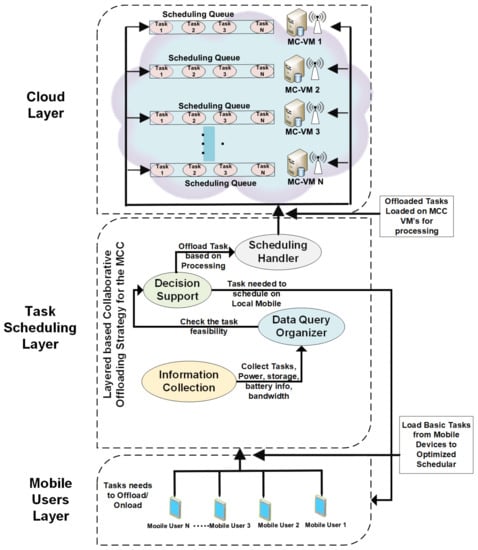
Figure 1.
System architecture with task processing and scheduling strategies.
- (a)
- Scheduling Handler: Handle multiple application services access and provide a dynamic scheduling technique for managing and distributing numerous services over the cloud.
- (b)
- Information Collection: Collect all information from the mobile devices accessing the services, like power information, processing, storage, battery information, bandwidth, processing capacity.
- (c)
- Information Processing/Checking: This part of the processor checks the above information to assess that the particular cloud service is suitable for handling the different mobile devices or not.
- (d)
- Scheduling Information Keeper: This Information Collaboration Site (ICS) module is important because it keeps the information related to the cloud services and some other information whilst the service is being used by a specific mobile device. After completion, the ICS automatically deletes the information from its storage.
- (e)
- Decision Support (DS): The DS module decides about the processing and other mobile device capacities and decides whether to allocate the cloud services to the mobile or not. The final allocation is based on the decision of this module.
- (f)
- Data Query Organizer (DQO): The DQO is responsible for data inflow and outflow from cloud services based on what type of request is received, and what kind of service needs to be distributed to the mobile client. Besides, to handle the computational costs and the results of the data query returned from the cloud processors.
Figure 2 and Figure 3 depict the working of the task scheduling layer. All three layers are processed according to their assigned tasks. Initially, the information collection module of Layer 2 receives the mobile devices’ data for strategic decision-making. When the task is not sufficient for the local mobile device computation, the data query organizer organizes and supports this device to process these steps. The task passed from the data query organizer is now well established and ready to decide the task offloading towards the cloud layer. The scheduling handler manages and finalizes the offload to the mobile cloud layer. The complete strategy is a layer-based collaborative offloading strategy to offload the tasks to the mobile cloud layer.
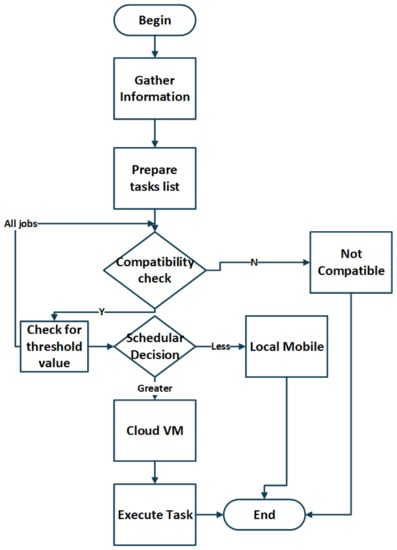
Figure 2.
Task Flow Diagram.
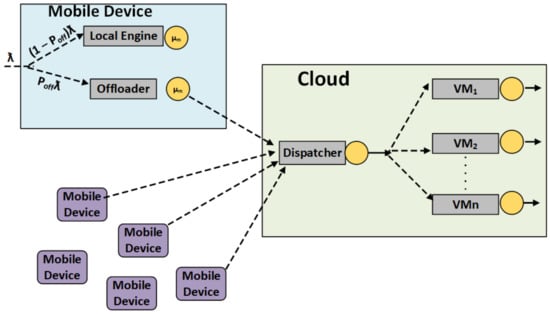
Figure 3.
Network Distribution Model for Mobile Cloud System.
In our proposed system, whole scheduling and fault tolerance methods are handled at the middle layer. The decision is made at this layer before the request has reached the cloud for processing and handling. Figure 2 shows the system model diagram, which consists of the flow of tasks from one module of the prosed MCC system to another. Scheduling of the jobs needs to be handled by the scheduler, whereas the jobs need to be submitted to the MCC for processing.
System Model
Our proposed model constructs two separate networks: task handling and VM networking to process task distribution and task handling. There are two basic networking models, one for mobile devices. The mobile device can process basic applications and enhance the capabilities for classifying the network system, consisting of a mobile device local engine and mobile device off-loader for offloading the tasks/jobs to the cloud for the relevant processing. The equation that describes the local engine to solve the task is (1 − Poff)λ. The task offloading capability of the mobile devices is checked based on the job’s time for every task. The time calculation probability on the mobile device is calculated with Equation (1). The model represents the local mobile calculation and task submission towards the mobile cloud. (1 − Poff)λ represents the time subtracted from the total mobile calculated time.
ΔTtotal mobile = ΔTm + ΔTe − ΔTec − ΔTon − (1 − ΔToff)
In Equation (1), ΔTtotal mobile calculates the total time of the local mobile for calculation and submission for processing. In this equation, the λ represents the system’s job request rate that required the mobile to get jobs/tasks from the devices. The ΔTtotal mobile total time indicates the total time for calculations on mobile devices. Similarly, if it requires a job to be scheduled on the cloud for the dispatcher/scheduler, its time is calculated using
where ƩToffλ is the precise time for task submission until dispatch for scheduling. Furthermore, the scheduler can reject any task based on the task’s information with proper execution and extension. The total time from process load to return after execution on the cloud is calculated with Equation (3). In Equation (3), ƩTtotalλ represents the total time from when the process starts to create and finalize the computed values.
ƩToffλ = ΔTon + ΔTe + ΔTm + ΔToff
ƩTtotalλ = Poff(ΔToff + ΔTec) + (1 + ΔTon + ΔTm)
We have used offloading based on the FCFS (First Come First Served) and the priority-based hybrid model of the offloading queue for dispatching to the cloud for execution in this model.
Job J is the set of all independent tasks executed on Central Processing Unit (CPU) cores based on Nt(j). The numbers of tasks collectively form the whole job for execution, and if the mobile contains a single core, then the tasks are done one after another in a sequential manner or if the mobile has multiple CPU cores, Nc, all tasks are executed in a parallel manner. While on the other hand, on the cloud, all jobs/tasks will be executed in parallel on different cloud virtual machines. To speed up the execution of a job/task, we take the ratio of execution of the tasks and jobs for which it is executed. So,
where α is the clock frequency ratio for mobile CPU cores and VM processors. The fault rate of any mobile device is estimated using the following information from the mobile device before dispatching it to the cloud. Power is a significant concern for handling the fault rate. To manage power resources, we needed to adapt to the data rate of the mobile device that needed to be handled. For task offloading, we checked the task probability first to determine if the task should be offloaded to the cloud because, for some tasks/jobs, the mobile device can handle them using Equation (5).
where U is the union of all tasks that group together a job for offloading, λ is the request rate of a mobile needing to execute on the cloud, Nt(j) is the total number of tasks performed on the cloud, C is the job size (mainly in instructions), A is the clock frequency ratio of the mobile core processor, Nc. In this model, first, the task is checked to determine whether the mobile CPU core(s) can handle the job. If they can, then the task will be executed on the mobile. Otherwise, it will be offloaded to cloud VM, which is modeled in the next step. Amoretti et al. [19] developed a model for offloading based on the energy consumed to execute by the mobile is higher than the energy consumed by the cloud VM. Still, in our approach, the power will also be wasted due to the massive network consumption power. We checked for fault tolerance based on mobile battery information, location information, and mobile storage information by using the following model.
F = α Nt(j)/Nc
Equation (6) describes the battery information through the specified threshold.
Equation (7) represents the mobile location, with no changes to the new low bandwidth network.
Mloc (B) ≥ Mnew-loc(B)
In Equation (8), the mobile storage is less than that of the output results produced from the cloud VM to the mobile.
Mstorage < B + Cloudoutput
In our research case, we needed to handle the fault tolerance before the task is distributed to the cloud. This helps the dispatcher check all the mobile device’s required details to dispatch to the cloud plate form. Figure 3 shows the execution sequence of task processing from the local mobile device towards the MCC. The estimated Time ΔTec is reflected from the scheduler.
The task scheduling process based on Algorithm 1 (below), which estimates the job, needs to be executed on mobile and the job performed on the cloud VM. Initially, the algorithm gathers the mobile device information through mob_info(T, B, L, S, App), the number of jobs through jobs_num(m), the number of mobile nodes with nodes_num(n), and gets the mobile information with fetch_info(T). Based on the information gained through steps 1, 2, 3, and 4, new mobile cloud nodes, a job schedular, and cloud VMs are created. The mobile device sends the information to the schedular with arguments. If the execution time is less than the justified threshold value, then the task should be processed on the mobile cloud, and if the task is heavyweight, then the task is uploaded towards the cloud VM. The equation below in step 7 of the cloud estimation plan based on this approach allows the system to continuously check the job execution time computed through Equations (1)–(3). The system then schedules the task for either the cloud VM or local mobile devices. Finally, the algorithm returns the job state.
| Algorithm 1. Task Scheduling Decision |
| Input: Input from Table 1 (LEGENDS Table) Output: Returns the state of the job submitted to the cloud or processed on mobile device/decision about mobile or cloud execution |
|
4. Simulation Environment
To evaluate the effectiveness of the proposed model for MCC, we implemented a simulation based on a mobile cloud simulator called CloudSIM and a mobile cloud simulator called Cloud Analyst (which is based on CloudSIM with an improved GUI interface). To the best of our knowledge, the CloudSIM is the best simulator for the simulation of Cloud and MCC environments, just like real-world environments. Cloud Analyst, built on top of CloudSIM, is a very active and user-friendly environment for a specific mobile cloud simulation setup. CloudSIM simulator is for mobile simulation on local machines with limited battery, processing (number of CPUs and cores), RAM, Internet and bandwidth, processing time (in milliseconds), etc. First, we simulated the results based on task availability on local machine simulations. If the cloud affected local machines, then the simulator was working fine on the availability of tasks on the local mobile. Based on the task information and mobile capacity information, the simulator would choose the probability and perform all of the local mobile simulations. At first mobile, we evaluated the information that we obtained in the following fashion.
We took ten chosen tasks randomly from the system in the initial simulations and considered the first iteration for simulation for the results extraction. Table 2 shows the information that is extracted from the tasks using a mobile phone. ΔTtotal mobile is the time calculated using Equation (1) from the above simulations. When using the total time for mobile execution, the system must represent the following calculation as an example. The information is collected after simulation steps and it provides the complete details of the tasks and their processing capabilities. Based on the data captured from the mobile devices, the CM and the local mobile devices are ready to process the data after the scheduler’s decision.
ΔTtotal mobile = 0.5 + 0.7 − 0 − 0 − (1 − 0)
= 1.2 ms
= 1.2 ms

Table 2.
List of parameters and variables used in the system.
Related to these calculations, we cleared that the first task was evaluated in line with the above calculations. Next in the list, we calculated all the jobs requiring calculation using Table 3.

Table 3.
Task Data Collected through CloudSIM Simulator.
ƩToffλ is the tasks offloading time. For MCC, it is the total time for the task being shifted from the local mobile to the cloud. This time is evaluated by Equation (2) from the model and for the evaluation of offloading time using Equation (2) for task 1 we have
ƩToffλ = ΔTon + (ΔTtotal mobile − ΔTm) + ΔTm + ΔToff
ƩToffλ = 0.012 + (1.2 − 0.5) + 0.5 + 2.31
= 3.342 ms
ƩToffλ = 0.012 + (1.2 − 0.5) + 0.5 + 2.31
= 3.342 ms
After calculating all ƩToffλ times for the calculations, we simulate and extract the results based on the simulation scenarios. Figure 4 depicts the actual results to get the tasks processed on MCC or local mobile devices.
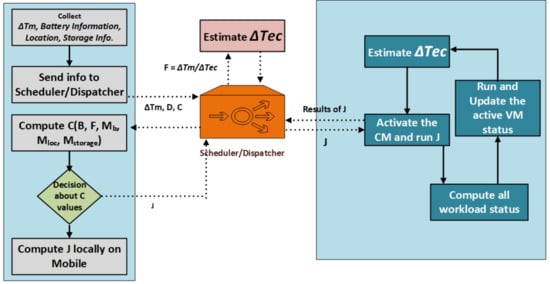
Figure 4.
Job execution sequence in MCC.
ƩTtotalλ time is the total time from task creation from the mobile device to the cloud. This time includes the time in which the mobile device decides the offloading or local device calculations. The decision taken by the mobile is that the device is ready to offload. Figure 5 shows the time calculation completed with offloading time and the time required by the cloud VM for execution. From Equation (3), we calculated the total time for a task from the mobile device to the cloud for processing with the formulae below.
ƩTtotalλ = (ΔToff + ΔTec) + (1 + ΔTon + ΔTm)
ƩTtotalλ = (3.342 + 1.2) + (1 + 0.3 + 0.5)
ƩTtotalλ = (4.542) + (1.8)
ƩTtotalλ = (6.342) ms
ƩTtotalλ = (3.342 + 1.2) + (1 + 0.3 + 0.5)
ƩTtotalλ = (4.542) + (1.8)
ƩTtotalλ = (6.342) ms
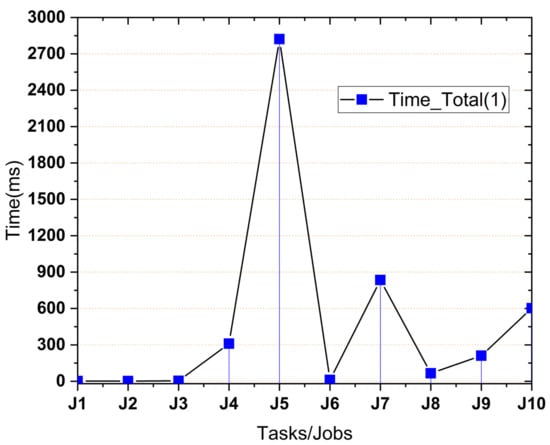
Figure 5.
Time calculations on the mobile device.
The total time for a task is used for decision purposes to calculate the task for offload, calculations for the cloud, and calculations for the mobile. Figure 6 shows the percentage of power consumed by the tasks. Some tasks show that higher power consumption means these tasks should be offloaded for MCC, and other tasks should be executed on local mobile devices.
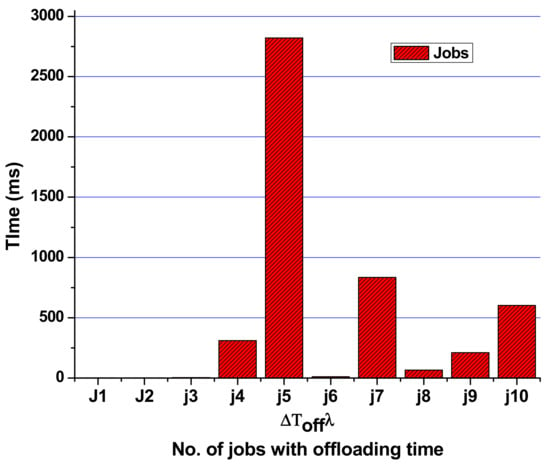
Figure 6.
Total offloading time from MCC to the cloud virtual machine (VM).
Time consumption ƩTtotalλ with power P was used for the tasks at different time intervals during the simulations. Figure 7 shows the comparison of task total time and power used by the task for processing on the mobile and cloud in the proposed system. It is observed that if tasks are increased in batch (number of jobs become batch), the calculations are less, so the power required for the task is less than other techniques. The probability is computed through Equation (8). After the computation of the probability, Figure 8 shows the highest and lowest offloading probability for task processing energy optimization. There are two approaches, P and T. P shows our proposed algorithm, and T shows the existing approach [22]. We analyze the energy of the tasks from 2000 to 20,000 energy efficiency costs for all tasks. Based on the graphs, we conclude that the proposed technique efficiently reduces energy consumption while offloading the tasks. On every single node, all the results effectively handle the tasks offloading and processing energy consumption for mobile and VM processing.
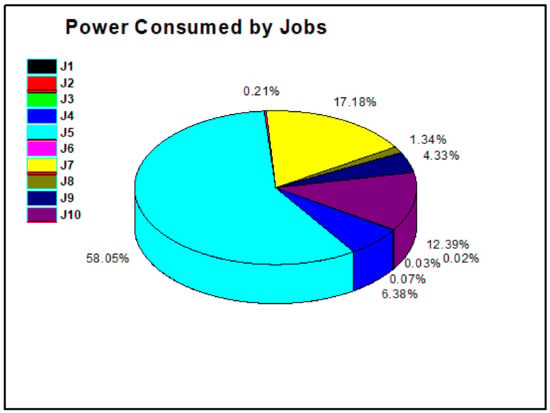
Figure 7.
ƩTtotalλ with power P used for the jobs.
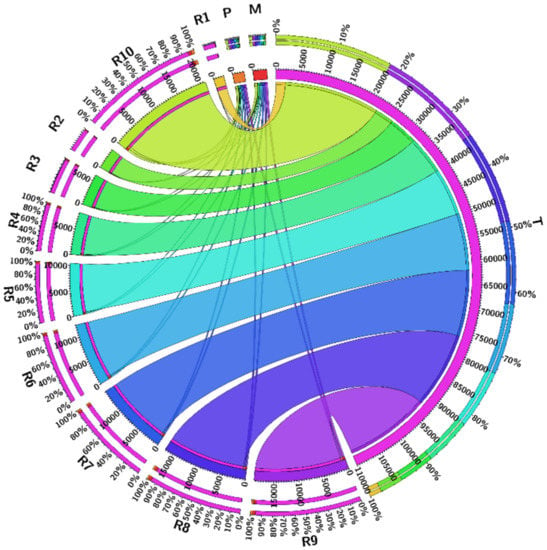
Figure 8.
Energy optimization results for the proposed technique in comparison with Mukherjee et al. [22].
Task offloading time ƩToffλ from Equation (2), is the total time we need to offload the responsibility from the mobile to another if it uses the battery power of the mobile machine. So for passing the results of the remaining time, Equation (5) is used with the constraints from Equations (6)–(8). From this, it is observed that only the tasks that have a computation time higher than the required calculations are shifted to the cloud VM for calculations. Figure 9 shows the time and task offloading decisions based on calculations.
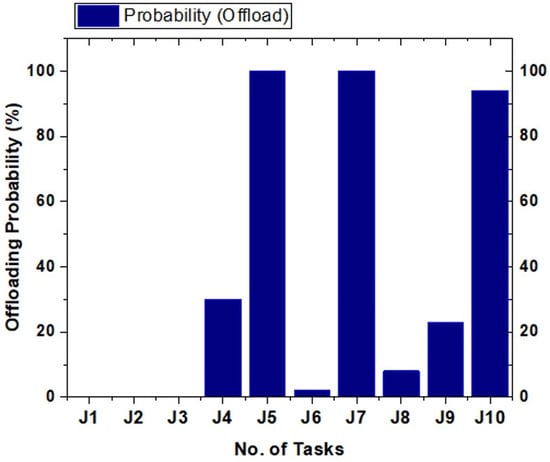
Figure 9.
The decision of task offloading probability.
The major decision is based on the task execution time. The load on the cloud is decreased because we do not offload jobs to the cloud VM until it possesses the required probability value, which is set to offload the jobs for processing on the cloud VM. Figure 10 shows the probability of tasks transferred to the cloud VM and demonstrates that the proposed system requires fewer results than the existing system in [22].
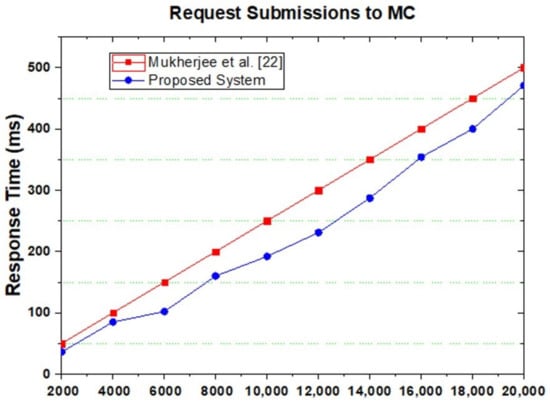
Figure 10.
Request submitted to the cloud of Mukherjee et al. [22] and proposed system.
For the probability of task offloading and scheduling tasks for transfer to the cloud VM for high processing, Equation (5) is used with the conditions checked through Equations (6)–(8), respectively, after the simulation takes place. The simulation setup based on the results calculates the task scheduling based on the algorithm proposed in the system. The probability and statistics results for the tasks of the mobile device configurations are shown in Figure 11. The graph clearly indicates that task processing energy is optimized from T to P. As its shows that T consumes higher power than P on every job from the proposed approach effectively saves the processing energy from the mobile device for MCC, the consequences of the final task offloading decision are based on the following indicators:
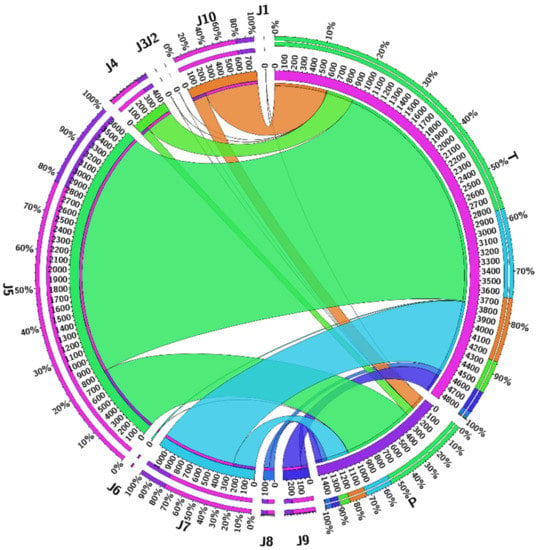
Figure 11.
Energy optimization request submitted to the cloud of Mukherjee et al. [22] and proposed system.
- Battery information
- Bandwidth
- Storage
- Offloading time
- Job completion rate
Table 4 shows the mobile device’s indicators to offload the task based on the statistics of the mobile device to execute tasks, which are related to the various job scenarios. Certain task times are significantly above the specified threshold value. The scheduler will schedule the offload based on these results.

Table 4.
Mobile Task Decision based on the Time from Mobile Device to Cloud.
5. Conclusions
This paper presents a proposal and simulation relative to MCC and the Cloud VM with a task scheduling technique based on the task time parameter. We explored task scheduling and task enhancement effects on MCC to improve the performance of mobile devices. Based on the proposed model in this paper, we submit a new task scheduling policy that incorporates and provides offloading mobile device calculation and offloading probability based on the time calculation of different scenarios of task scheduling from the mobile device to the cloud. MCC is an essential factor in offloading the tasks, which significantly affects the task handling and task scheduling policies from mobile devices to cloud resources. The technique enables mobile users to effectively balance the time bounds for efficient time handling capabilities. We considered two scenarios; the first involved tasks being executed on mobile devices. The second involved tasks being completed on the cloud VM. Time and energy constraints were used to assess when time efficiency had been achieved, and energy automatically managed. Our proposal scheduled shorter execution time and energy-optimized tasks to mobile devices, with larger and energy-intensive tasks being offloaded to the cloud. Our strategy effectively achieves time efficiency, energy efficiency, better performance, higher resource utilization, and task execution success without diminishing performance quality. Moreover, the results showed that the jobs which go beyond the time thresholds will be shifted to the cloud VM for processing to save the mobile device’s limited battery power.
6. Future Work
We will consider a privacy-aware and authentic approach to handle task scheduling. We will determine better task modeling and decision-making capabilities by using blockchain-based privacy-aware task scheduling through MCC as a better and essential research direction. In this regard, the currently applied model will provide better support for this work.
Author Contributions
Data curation, F.J.; formal analysis, A.A.; funding acquisition, M.M.I., O.C., M.B. and F.J.; methodology, M.M.I. and F.J.; project administration, M.M.I. and F.J.; supervision, S.J., O.C. and M.B.; visualization, H.J., F.Q. and S.J.; writing – original draft, A.A.; writing – review & editing, H.J., F.Q. and S.J. All authors have read and agreed to the published version of the manuscript.
Funding
This work is supported by Taif University Researcher Supporting Project number (TURSP-2020/239), Taif University, Taif, Saudi Arabia.
Institutional Review Board Statement
Not applicable.
Informed Consent Statement
Not applicable.
Data Availability Statement
Not applicable.
Acknowledgments
The authors thank Taif University Researcher Supporting Project number (TURSP-2020/239), Taif University, Taif, Saudi Arabia.
Conflicts of Interest
The authors declare no conflict of interest.
References
- Zhou, Y.; Tian, L.; Liu, L.; Qi, Y. Fog computing enabled future mobile communication networks: A convergence of communication and computing. IEEE Commun. Mag. 2019, 57, 20–27. [Google Scholar] [CrossRef]
- Yeniyurt, S.; Wu, F.; Kim, D.; Cavusgil, S.T. Information technology resources, innovativeness, and supply chain capabilities as drivers of business performance: A retrospective and future research directions. Ind. Mark. Manag. 2019, 79, 46–52. [Google Scholar] [CrossRef]
- Wu, S.; Niu, C.; Rao, J.; Jin, H.; Dai, X. Container-based cloud platform for mobile computation offloading. In Proceedings of the 2017 IEEE International Parallel and Distributed Processing Symposium (IPDPS), Orlando, FL, USA, 29 May–2 June 2017. [Google Scholar]
- Allam, H.; Nassiri, N.; Rajan, A.; Ahmad, J. A critical overview of latest challenges and solutions of Mobile Cloud Computing. In Proceedings of the 2017 Second International Conference on Fog and Mobile Edge Computing (FMEC), Valencia, Spain, 8–11 May 2017. [Google Scholar]
- Chen, M.; Guo, S.; Liu, K.; Liao, X.; Xiao, B. Robust Computation Offloading and Resource Scheduling in Cloudlet-based Mobile Cloud Computing. IEEE Trans. Mob. Comput. 2020, 20, 2025–2040. [Google Scholar] [CrossRef]
- Tawalbeh, L.A.A.; Ababneh, F.; Jararweh, Y.; AlDosari, F. Trust delegation-based secure mobile cloud computing framework. Int. J. Inf. Comput. Secur. 2017, 9, 36–48. [Google Scholar] [CrossRef]
- You, C.; Huang, K.; Chae, H. Energy efficient mobile cloud computing powered by wireless energy transfer. IEEE J. Sel. Areas Commun. 2016, 34, 1757–1771. [Google Scholar] [CrossRef] [Green Version]
- Sisodiya, N.; Dube, N.; Thakkar, P. Next-Generation Artificial Intelligence Techniques for Satellite Data Processing. In Artificial Intelligence Techniques for Satellite Image Analysis; Springer: Berlin, Germany, 2020; pp. 235–254. [Google Scholar]
- Huang, Q.; Zhang, Z.; Yang, Y. Privacy-Preserving Media Sharing with Scalable Access Control and Secure Deduplication in Mobile Cloud Computing. IEEE Trans. Mob. Comput. 2021, 20, 1951–1964. [Google Scholar] [CrossRef]
- Goyal, M.; Sharma, A. A Mobile-Cloud Framework with Active Monitoring on Cluster of Cloud Service Providers. In International Conference on Innovative Computing and Communications; Springer: Berlin, Germany, 2020. [Google Scholar]
- Abolfazli, S.; Sanaei, Z.; Sanaei, M.H.; Shojafar, M.; Gani, A. Mobile Cloud Computing; Wiley Online Library: Hoboken, NJ, USA, 2016; p. 29. [Google Scholar]
- Alkhalaileh, M.; Calheiros, R.N.; Nguyen, Q.V.; Javadi, B. Dynamic resource allocation in hybrid mobile cloud computing for data-intensive applications. In Proceedings of the International Conference on Green, Pervasive, and Cloud Computing, Uberlândia, Brazil, 26–28 May 2019. [Google Scholar]
- Stiles, J. Working at Home and Elsewhere in the City: Mobile Cloud Computing, Telework, and Urban Travel. Ph.D. Thesis, Rutgers University-School of Graduate Studies, New Brunswick, NJ, USA, 2019. [Google Scholar]
- Aslam, B.; Abid, R.; Rizwan, M.; Ahmad, F.; Sattar, M.U. Heterogeneity Model for Wireless Mobile Cloud Computing & its Future Challenges. In Proceedings of the 2019 International Conference on Electrical, Communication, and Computer Engineering (ICECCE), Swat, Pakistan, 24–25 July 2019. [Google Scholar]
- Singh, S.; Sidhu, J. Compliance-based multi-dimensional trust evaluation system for determining trustworthiness of cloud service providers. Future Gener. Comput. Syst. 2017, 67, 109–132. [Google Scholar] [CrossRef]
- Milind, B.; Tiwari, A.K. An Assessment of Cloud Computing and Mobile Cloud Computing in E-Learning. In Computing Algorithms with Applications in Engineering; Springer: Berlin, Germany, 2020; pp. 21–36. [Google Scholar]
- Prasad, R.; Rohokale, V. Cloud Computing. In Cyber Security: The Lifeline of Information and Communication Technology; Springer: Berlin, Germany, 2020; pp. 111–124. [Google Scholar]
- Thakkar, S.; Basak, D.; Maskalik, S.; Wu, W.; Bhagwat, A.V.; VMware Inc. Cloud Virtual Machine Defragmentation for Hybrid Cloud Infrastructure. Patent US10282222B2, 7 May 2019. [Google Scholar]
- Lakhan, A.; Li, X. Transient fault aware application partitioning computational offloading algorithm in microservices based mobile cloudlet networks. Computing 2020, 102, 105–139. [Google Scholar] [CrossRef]
- Noraziah, A.; Herawan, T.; Rahman, M.T.A.; Abdullah, Z.; Mustafa, B.A.; Fakharaldien, M.A.I. Fault Tolerance Impact on Near Field Communication for Data Storage of Mobile Commerce Technology in Cloud Computing. In Proceedings of the International Conference on Data Engineering 2015 (DaEng-2015), Bali, Indonesia, 25–26 April 2019. [Google Scholar]
- Sudha, M.; Usha, J. A Novel Fault Tolerant Approach using Patterns for Private Cloud Environment. Int. J. Comput. Sci. Inf. Secur. IJCSIS 2019, 17. Available online: https://www.researchgate.net/profile/M-Sudha/publication/338005610_A_Novel_Fault_Tolerant_Approach_using_Patterns_for_Private_Cloud_Environment/links/5df9d79ea6fdcc283728f2f7/A-Novel-Fault-Tolerant-Approach-using-Patterns-for-Private-Cloud-Environment.pdf (accessed on 15 April 2021).
- Annane, B.; Ghazali, O.; Alti, A. A new secure proxy-based distributed virtual machines management in mobile cloud computing. Int. J. Adv. Comput. Res. 2019, 9, 222–231. [Google Scholar] [CrossRef] [Green Version]
- Chen, C.-A.; Stoleru, R.; Xie, G.G. Energy-efficient and fault-tolerant mobile cloud storage. In Proceedings of the 2016 5th IEEE International Conference on Cloud Networking (Cloudnet), Pisa, Italy, 3–5 October 2016. [Google Scholar]
- Park, J.; Yu, H.; Kim, H.; Lee, E. Dynamic group-based fault tolerance technique for reliable resource management in mobile cloud computing. Concurr. Comput. Pract. Exp. 2016, 28, 2756–2769. [Google Scholar] [CrossRef]
- Li, C.; Zhang, J.; Ma, T.; Tang, H.; Zhang, L.; Luo, Y. Data locality optimization based on data migration and hotspots prediction in geo-distributed cloud environment. Knowl. Based Syst. 2019, 165, 321–334. [Google Scholar] [CrossRef]
- Abd, S.K.; Al-Haddad, S.A.R.; Hashim, F.; Abdullah, A.B.H.J.; Yussof, S. Energy-aware fault tolerant task offloading of mobile cloud computing. In Proceedings of the 2017 5th IEEE International Conference on Mobile Cloud Computing, Services, and Engineering (MobileCloud), San Francisco, CA, USA, 6–8 April 2017. [Google Scholar]
- Schmidt, R.W.; Moeller, J.; Sweet, M.R.; VMware Inc. Cloud Computing Nodes for Aggregating Cloud Computing Resources from Multiple Sources. U.S. Patent 9,467,395, 11 October 2016. [Google Scholar]
- Guo, Z.; Ren, X.; Ren, F. Better Realization of Mobile Cloud Computing Using Mobile Network Computers. Wirel. Pers. Commun. 2019, 111, 1805–1819. [Google Scholar] [CrossRef]
- Siddavaatam, R.; Woungang, I.; Carvalho, G.H.S.; Anpalagan, A. Mobile cloud storage over 5G: A mechanism design approach. IEEE Syst. J. 2019, 13, 4060–4071. [Google Scholar] [CrossRef]
- Lee, J.; Gil, J. Adaptive fault-tolerant scheduling strategies for mobile cloud computing. J. Supercomput. 2019, 75, 4472–4488. [Google Scholar] [CrossRef]
- Raju, D.N.; Saritha, V. Architecture for fault tolerance in mobile cloud computing using disease resistance approach. Int. J. Commun. Netw. Inf. Secur. 2016, 8, 112. [Google Scholar]
- Al-Sayed, M.M.; Khattab, S.; Omara, F.A. Prediction mechanisms for monitoring state of cloud resources using Markov chain model. J. Parallel Distrib. Comput. 2016, 96, 163–171. [Google Scholar] [CrossRef]
- Keshanchi, B.; Souri, A.; Navimipour, N.J. An improved genetic algorithm for task scheduling in the cloud environments using the priority queues: Formal verification, simulation, and statistical testing. J. Syst. Softw. 2017, 124, 1–21. [Google Scholar] [CrossRef]
- Peng, H.; Wen, W.S.; Tseng, M.L.; Li, L.L. Joint optimization method for task scheduling time and energy consumption in mobile cloud computing environment. Appl. Soft Comput. 2019, 80, 534–545. [Google Scholar] [CrossRef]
- Tang, C.; Hao, M.; Wei, X.; Chen, W. Energy-aware task scheduling in mobile cloud computing. Distrib. Parallel Databases 2018, 36, 529–553. [Google Scholar] [CrossRef]
- Lin, X.; Wang, Y.; Xie, Q.; Pedram, M. Energy and performance-aware task scheduling in a mobile cloud computing environment. In Proceedings of the 2014 IEEE 7th International Conference on Cloud Computing, Anchorage, AK, USA, 27 June–2 July 2014. [Google Scholar]
- Guo, S.; Xiao, B.; Yang, Y.; Yang, Y. Energy-efficient dynamic offloading and resource scheduling in mobile cloud computing. In Proceedings of the IEEE INFOCOM 2016-The 35th Annual IEEE International Conference on Computer Communications, San Francisco, CA, USA, 10–14 April 2016. [Google Scholar]
- Wei, X.; Fan, J.; Lu, Z.; Ding, K. Application scheduling in mobile cloud computing with load balancing. J. Appl. Math. 2013, 2013, 409539. [Google Scholar] [CrossRef] [Green Version]
- Nawrocki, P.; Sniezynski, B. Adaptive service management in mobile cloud computing by means of supervised and reinforcement learning. J. Netw. Syst. Manag. 2018, 26, 1–22. [Google Scholar] [CrossRef]
- Akki, P.; Vijayarajan, V. Energy efficient resource scheduling using optimization based neural network in mobile cloud computing. Wirel. Pers. Commun. 2020, 114, 1785–1804. [Google Scholar] [CrossRef]
- Shakarami, A.; Ghobaei-Arani, M.; Masdari, M.; Hosseinzadeh, M. A Survey on the Computation Offloading Approaches in Mobile Edge/Cloud Computing Environment: A Stochastic-based Perspective. J. Grid Comput. 2020, 18, 639–671. [Google Scholar] [CrossRef]
Publisher’s Note: MDPI stays neutral with regard to jurisdictional claims in published maps and institutional affiliations. |
© 2021 by the authors. Licensee MDPI, Basel, Switzerland. This article is an open access article distributed under the terms and conditions of the Creative Commons Attribution (CC BY) license (https://creativecommons.org/licenses/by/4.0/).